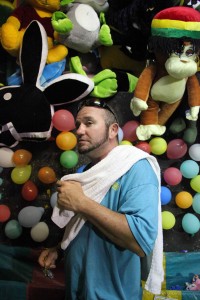 The recently deceased, transsexuals, female impersonators – photographer Jeffrey Silverthorne, a professor in the visual arts department at Roger Williams University, flocks to these subjects like a moth to flame. Most known for Morgue Series, a collection of photos of the freshly dead in a Rhode Island morgue, his work is as grotesque as it is gorgeous. Earlier this month, Silverthorne answered a few questions about himself and his perfect vacation.
The recently deceased, transsexuals, female impersonators – photographer Jeffrey Silverthorne, a professor in the visual arts department at Roger Williams University, flocks to these subjects like a moth to flame. Most known for Morgue Series, a collection of photos of the freshly dead in a Rhode Island morgue, his work is as grotesque as it is gorgeous. Earlier this month, Silverthorne answered a few questions about himself and his perfect vacation.
Dale J Rappaneau, Jr.: In 2011, you told of a woman finding peace within your Morgue Series after her husband passed away in Vietnam. You go on to say that you’re “not always that empathetic,” and that your response was not joy for the woman, but relief that she wasn’t angry with the photos. Does this lack of empathy help your ability to photograph graphic subjects?
Jeffrey Silverthorne: It is not that I am not empathetic. The reality is that I am there being curious and making photographs, pictures, that reflect the situation and my curiosity. The greatest danger is to go into a situation with specific pictures in mind, because then you only see your expectations. My momentary comfort of not being yelled at by the woman whose husband who was killed in Vietnam is one thing, but the larger issue is that if I, the picture maker, worked by what was, is, considered nice, polite, then these pictures, and numerous others, would never have been made. I usually know when I am taking advantage of people.
DJR: In the same interview, you claim that the American culture prefers things to be “nice,” citing as an example that “we invented Disneyland.” Do you think it inappropriate for individuals to pursue nice things?
JS: “Nice” – and words like that – when not explained, when not given a context and understanding, are insults to thinking. It is very difficult work to make gentle or tender pictures that speak to the beauty, ephemerality, and strength of relationships and life. When making useless placebos and not thinking are accepted as anything beyond that, then there is a problem, and this country has a lot of problems.
DJR: Have you ever been to Disneyland?
JS: I went to Disneyland, not Disney World, in 1968. It is of course fascinating to consider the use of fairy tales and myth in Disneyland and the USA in relation to what they were originally made for and how they have been made “nice” for commercial ventures and social control. If one psychologically steps outside commercial property, the world is a fascinating and wondrous place filled with beauty and violence.
DJR: What is Jeffrey Silverthorne’s ideal vacation?
JS: My ideal vacation is an opportunity to look, an opportunity to wonder. I have no interest and small patience for sitting still. Meditation, which I highly recommend, and I have a fluctuating relationship. Life is my opportunity to see things and ideas that I don’t know. I think it’s best to look now, soon, as we will each be dead for much longer than we have been alive.
DJR: Lastly, what is your best piece of advice for today’s up-and-coming photographers?
JS: Nobody really cares whether you make pictures or not, but if you don’t do the work that you wonder about, that you are curious to see just what in the heck happens, that you believe in, it will never be done. Your work is your responsibility.


